R. Lawson Gamble's Blog: R Lawson Gamble Books, page 15
June 25, 2016
A Cautionary Tail
I am moved to write this brief caution in reaction to the disappointment some reviewers express when my novels take an unexpected (to them) turn at the end. On my author page at Amazon, in my bio and description I have tried to make it clear that the evil Zack Tolliver and Eagle Feather encounter is often otherworldly; native cultural myth come to life. Yet some readers appear to have overlooked, forgotten, or not known this, judging from their apparent shock and dismay.
I do not, nor have I ever tried to write a Hillerman-like novel about Native Americans–there are more than enough authors competing for that role, including the man’s own daughter. I try to write down that which excites me, disturbs me, maybe even frightens me; the what-ifs that lurk just beyond all of our imaginings in a setting I have always loved, the American West. I feel for the reader who becomes engaged in my story expecting a reasonable, tidy wrap-up at the conclusion. Ain’t gonna happen.
I will say there are copious hints scattered along the way to raise Zack and Eagle Feather’s (and the reader’s) suspicions that they are in pursuit of more than your average bad guy. Zack-like, some readers dismiss these, as most of us do in ‘real’ life, expecting the thread of our lives to continue on as it has always done. But what if it doesn’t?
I was pleased and honored to receive a review (for The Other) from a reader who is Dine. Acceptance of the evil entity Zack and Eagle Feather managed to defeat (at least for now) was complicit in the enjoyment this reader expressed. No shocked surprise here – such things have been around as long as the culture itself.
I leave you with Zack’s own words to the Criminology classes of Hancock College in the opening chapters of Zaca as he attempts to explain this very thing:
“Our culture tends to limit the possible far more than other cultures. My friend and mentor (Eagle Feather) taught me to avoid such limitations. One you close your mind to anything, it ceases to exist for you. But for others, it may still be there.”
Tagged: CAT, Mestaclocan, Native American, native cultures, R Lawson Gamble, reader expectations, supernatural, The Other, thrillers, Zaca


June 15, 2016
The Frustrations of Formatting
It is not my purpose here to talk about the technical aspects of formatting a self-publish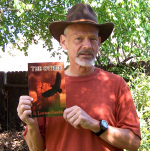 ed book. Experts abound, and I am eternally grateful for that fact. When I become immersed in the swamp of details or flummoxed by the idiot-syncrasies of Microsoft Word, I head for the chat rooms. This article is meant as an overview; my thoughts on the major challenges, how I deal with some of them, and perhaps as a sympathetic diatribe.
ed book. Experts abound, and I am eternally grateful for that fact. When I become immersed in the swamp of details or flummoxed by the idiot-syncrasies of Microsoft Word, I head for the chat rooms. This article is meant as an overview; my thoughts on the major challenges, how I deal with some of them, and perhaps as a sympathetic diatribe.
When setting about publishing a manuscript, my initial question is how first to publish it––as an eBook or a print version. Since my major publishing focus to date has been the eBook market, I lean toward publishing a Kindle as my first effort. I tell myself I may not even wish to publish a print book, or at the very least hold off a while, but ultimately the desire to own a hard copy of my work overcomes practicality, and I create one.
The fact is, it is far more difficult to format a book for print than for an eBook. More important, it is an entirely different process. My frustration level tends to reach new heights when formatting for print. Sure, I could pay Createspace to format my manuscript for me, but why do that if I already know how to do it myself? After formatting four books for print, I do know, don’t I?
This past month I published CAT, the fourth book in my Zack Tolliver, FBI series, as an eBook and then as a paperback. I found myself wrestling with the very same issues I had struggled with publishing my three preceding books. You’d think I would remember the process. But there are two problems: first, it is a long time between books and second, details of the process seem to change just a wee bit from year to year, even is the basic problems remain the same.
To create an eBook, it is not difficult to transform your manuscript to a PDF, keeping in mind not to add page numbers but also remembering to insert page breaks chapter to chapter. The trick is to think of the document as a continual scroll, with a space at each chapter heading. The difficulty comes with the TOC (Table of Contents), not required on most platforms but in reality a necessity for the convenience of the reader. And guess what? The Microsoft Word TOC will not function on Kindle. Smashword supplies a simplistic TOC when crunching your manuscript with its machine, but to my mind it is barely functional, and certainly not fancy.
What to do? I go back to the chatrooms to find someone with a solution I can understand. I must be specific in the search, I use Microsoft Word 2011 for Mac. Other versions will not help me. But you’ve got to love Google; the answer is always out there somewhere. The key in my version of Word is I must create a whole series of hyperlinks in the TOC, chapter by chapter. The best step-by-step explanation I have found is here: http://www.engadget.com/2012/05/05/ibook-lessons-creating-amazon-kdp-tables-of-contents-on-ms-word/ It is hopelessly tedious, but it works for me––hopefully it will work for you.
As for the cover––fageddaboutit. I am no artist and the cover is too important to end up less than wonderful. Remember, you will be using it for both eBook and print version, thus any problems become exponential. I farm it out to someone who knows what he/she is doing. It pays in the long run.
Okay, so what about the print version? Well, throw out everything you just learned about creating an eBook. Now you do need page numbers, but not everywhere; not in the front matter, not at the beginning of chapters, not for the back pages. How do you make Word do that? Only with a struggle. You also probably want your author name in the header on even pages, and your book title in the header on odd pages. But not at the beginning of chapters, not in the front matter, not on the back pages. Here’s a hint: it’s all done with page and section breaks, set up with specific instructions for headers and footers, chapter by chapter. And if you get one thing wrong––just one thing––all the page numbers you worked so hard to place might disappear, or all your header information on the even pages might go away, or suddenly appear in your front matter. Worst of all, you might not even notice it happened until too late.
That is just one aspect of the process. Don’t forget page appearance, bleed, margins, book size. If the setting is wrong, the material won’t fit on the page. Your margins must be just right to look right for your book size. Your line spacing just right, your font just right. Createspace, for instance, does not have all the same fonts as Word. Here’s another fun fact: font sizes don’t look the same in print as in your Word document. A 14 font, for instance, looks just right in Word but is huge in print, the 1.5 line spacing looks good in Word, but in print looks like the Red Sea between your lines.
So what to do? Head back to those chatrooms. Here’s the good part; I have found I actually do learn from experience, book to book. I don’t remember all the details each time, and some change, but I do remember the gist, which makes assimilating the info from chat rooms easier. In other words, it does get better.
I’ll say a word about the book cover. You will want to use the same cover from eBook to print, of course, but you can’t use the same size. In fact, you won’t know what size you need for your paperback until the manuscript is completely formatted and you have a precise page count. Otherwise, the cover won’t fit. If you do an audio book, you’ll need yet another cover size, but that is topic for another article.
It is not my intention to discourage beginning self-publishers––just the opposite. There is nothing like the feeling of holding your paperback book in your hand, your very own creation from top to bottom. It is well worth it. And when people begin to buy it, when you get your first fan, you tend to forget the time and trouble. The intent of this article is to serve as a gentle warning, to suggest there will be discouraging moments, and encourage you to persevere––and allow lots and lots of time.
Ultimately, you’ll be glad you did.
Tagged: bleed, book formatting, CAT, cover artist, Createspace, Ebook, font, footers, front matter, header, headers, kindle, line space, manuscript to print, margin, Microsoft Word, Microsoft Word for Mac 2011, PDF, self-publishing, SmashWord, TOC, Zack Tolliver


June 1, 2016
THE BLUE HALLS
Copyright©️2016 R Lawson Gamble. All rights to this work are reserved. No part of this work may be used or reproduced in part or in whole in any manner whatsoever without written permission from the author. In this work I describe actual locations and authentic time frames and global events. The characters, however, are fictional and any resemblance to events or persons living or dead, while possible given the nature of this work, is in fact unintentional and largely coincidental.
The Blue Halls
R Lawson Gamble
(The following excerpted from the journal of Mr. Jethro Tasker, Esquire)
Within the world of children there are many forbidden zones, places declared off-limits by adults that consequently become areas of particular allure to a child (all children being curious). Unseen, unexplored, the very names of these places tend to evoke mystery spiced with danger. These forbidden places become irresistible.
I applied to teach at a private junior boarding school for boys in a small New England town. Here children from across the country lived in a rambling pile of a structure built into a hillside. As the school expanded over its century long history, the building sprawled upward, outward and downward. By the time I arrived the structure had long ago reached the bottom of the slope, burrowed several stories into the earth and embraced much of the width of the hillside.
Like an insatiable beast, this monstrous construction consumed a hundred children deposited by parents and guardians in several barrack-like dormitories, where they lived their lives along with their dorm master. Non-dorm faculty and their wives lived in apartments hidden within this mouse’s maze, along with administrative offices, a library, a meeting hall, an art facility, a school store, a snack store, a sewing room where the resident matrons could care for the children’s bedding and apparel, a business office, and the stately Headmaster’s office positioned at one end of the entire arrangement like the captain’s quarters of a Spanish galleon. During my years at the school, I would discover many more rooms in this massive structure; some purposed, most not; others rumored to exist, which I never found.
From the street level, where the visitor entered, the whitewashed face of the structure deceived the eye with its simple lines and black shutters, suggesting a modest English Tavern style building designed to blend in with the New England small-town landscape, a bookend for the white-spired New England church across the way, thus effectively obfuscating the true nature of the architectural explosion that lurked beyond its portals.
The visitor parked on the street, walked through the wide white frame of the heavy-hinged door into a large reception area of dark wood and wainscoting where built-in benches with hinged tops doubled as storage along the walls. Here they waited for an appointment or for a child, seated upon thin embroidered cushions that barely insulated expensively clad buttocks from hard wood, unaware of the treasures of students past just inches below in the form of ball gloves, yo-yos, lost jackets and shoes. At the farthest end of the room through the soaring frame of the schoolroom door a prospective student caught his first frightening glimpse of row upon row of Dickensian study desks fixed to the floor, oriented toward a raised dais where sat the mighty supervisor’s desk, the entire scene presented through dim light like a spectral aura.
A more modest door to the right of the study hall led to the faculty room. This door, with its frosted glass window was usually closed; the only hint of activity beyond it the occasional over-loud voice, an explosion of laughter, or the flicker of movement ghosting in the opaque glass. In a corner next to the faculty room, upon a tall pedestal stood a full body bronze of Lincoln, tall in itself, projecting his serene countenance and wisdom upon the passerby. The visitor’s eye having passed full circle it now rested upon a Dutch door opposite; beyond it, the office of the Headmasters Secretary, from whence would come the Headmaster’s summons.
Other than the clacking of typewriter keys, a cave-like silence enveloped this space until the ear gradually attuned to the murmur of distant voices somewhere beyond the walls, or the creaking and groaning of ancient steps somewhere above.
Every wall, even the whitewashed expanses, gloomed dark; every door enclosed within walnut panels, the ceiling banded by black hand-hewn beams, the pine floors buried over time under layers of stain except here and there where the original patina peeked through, worn visible by years of frenetic feet.
My application was accepted, my lodging established in a nearby building where I was to become master to ten eighth grade boys. At the time I was young, spirited, and excited, stimulated by a vision of private school boarding life gleaned almost entirely from a John le Carre novel.
My charge was to teach music; in reality the job description on the contract was expanded well beyond that simple objective. My schedule of duties thus outlined kept me away from the “Old Building”, the name used to describe that rambling structure. At meals I presided over a table of fourteen boys in the Dining Room, situated directly beneath my apartment; my classroom was the floor of an infrequently used auditorium in yet another building, my coaching duties took me to the playing fields, and my evening duties were in my assigned dormitory. There was little reason for me to visit the Old Building in my busy life circuit with the exception of evening coffee in the faculty room or an infrequent summons to visit the business manager or the Headmaster. Even then, I saw little of that enigmatic edifice beyond the view afforded any casual visitor.
In the normal course of teaching music I received a few requests from parents to offer their child after-hours private instruction. Because my classroom in the distant gymnasium was off bounds to the boarders at night, I applied for a place to teach within the permitted evening routes, and in due course a small room heretofore used for storage was found for me in the Old Building. This tiny room was located in a lower level, reached by a creaky narrow stairway that descended from the passage the students must travel from study hall to library each evening. The stairwell was dark, the single perpetually dirty window on the middle landing insufficient to illuminate anything beyond itself, each wooden step worn down at the center by a century of hard-heeled shoes. My new studio door was immediately at the bottom of these stairs. Beyond it, the Blue Halls beckoned.
(End of first segment. Next segment will be published June 15)
Tagged: new novel, Original story, R Lawson Gamble new novel, serialized story


May 27, 2016
NEW SERIALIZED FICTION BEGINS JUNE 1
My next posting will be a segment of a brand new novel, a serialized book in progress. It is a work of fiction and as in my Zack Tolliver, FBI series , I describe actual locations and authentic time frames and global events. The characters, however, are fictional and any resemblance to events or persons living or dead, while possible given the nature of this work, is in fact unintentional and largely coincidental.
The novel is drawn from my experience working in a New England Junior Boarding School in the 70’s and 80’s, the age-old traditions in full flower upon my arrival, and their gradual demise.
I intend this serialized work as a regular feature once a month in this space until you and I and the novel have finished. My other postings, comments on writing and publishing and some historical research will continue to appear.
A statement of rights will precede each segment as follows: ©️2016 R Lawson Gamble. All rights to this work are reserved. No part of this work may be used or reproduced in part or in whole in any manner whatsoever without written permission from the author.


May 11, 2016
Selling Your Wares At Fairs
Craft Fairs are prolific. They occur all through the year, are a great boon to those selli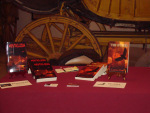 ng books, take on special significance at holiday time, and draw lots of people––and, of course, competition. How do you separate yourself from the crowd?
ng books, take on special significance at holiday time, and draw lots of people––and, of course, competition. How do you separate yourself from the crowd?
If your aim in participating in a fair is to make a profit, read on. There are other reasons to participate, of course, like gaining exposure for your work or simply to have fun. My thoughts today, though, are about profit.
First, consider some reasons not to participate in a certain craft fair.
1. The fair does not support the subject of your book(s). For example, it is difficult to sell a crime story involving child molestation to a fair themed for expectant mothers. That is extreme, of course, but you get the idea. I have discovered that many people come to fairs with a particular mind-set which often includes what they want to do there and what they intend to buy. If purchasing a book isn’t part of that vision, it will be difficult to sell them one.
2. Booth rental is too expensive. A high booth rental cost puts you in arrears immediately. The first part of the fair is spent in a panic trying to recover the cost of the booth in order to begin making a profit. True, high booth rentals often mean these spots are popular and possibly support good traffic. But sometimes not.
3. The fair is outdoors and you are not equipped for rain/wind/snow. Of course, it is difficult to know the weather in advance. Ask yourself first if an outdoor fair is for you. Fall, winter, and early spring are speculative in many parts of the country. If you can wait a while to submit, do so until you can make a reasonable guess about the weather. Some weather prognosticators offer up to twenty day forecasts which might at least indicate a pattern. Any doubt, get out. Remember, if you don’t feel like slogging through the rain to sell your books, your customers will feel the same about coming out to buy them.
4. The fair is poorly organized, poorly managed, poorly run. Maybe it’s the management’s first one ever. Mismanagement can cause all kinds of grief; duplicated rental spots, inability to supply answers to your questions, chaotic format, confusion about accepted payment forms, limited space, limited bathrooms, and so on. You can often spot a poorly managed fair by its registration form. I suggest you avoid them.
5. Think twice before signing up for a book fair. Why? This may seem counterintuitive, but the point is, there are too many choices. Unless you are a known author with a hot book it is difficult to separate yourself from all of the others. When there are too many fish in the sea, the buyer will tend to choose the first one or the most familiar one. A book is a commitment; no one wants to be stuck with a book they don’t like. Of course, you will want to support events sponsored by your local writers group by participating.
So you’ve decided to participate in a particular fair. What follows are just a few ideas to help you succeed.
1. Be sure you have your temporary sellers permit, if required. The organizer will usually announce this in the details. They can get burned if they allow non-permitted vendors. But they don’t always know this, or they don’t mention it and assume you are aware. The best idea is indeed to make yourself aware, ask questions, check with other vendors. Except in the case of some charitable events, one is generally required (and remember to pay the tax within the given framework of time, the tax people won’t remind you).
2. Invest in your own table. Book covers sell books and attractive displays hi-light your book covers. You may not require an 8 or 10 foot table, the size usually supplied by institutions. I use my own four-foot table. I plan and set up my display in advance, then replicate it at the fair. An eight or ten foot table is too large for me, the long empty expanse makes my display seem unfinished. Put out enough books to show you have plenty, but not so many your table confuses the eye. When my four-foot table becomes too small, I will move up to six feet.
3. Don’t confuse the customer by displaying too many choices. If you have published twenty books, congratulations. But don’t put them all in your display, or at least not multiple copies. Put out two or three of your best grabby covers, with several copies of each, a few other single titles, and for the rest, a listing, preferably on glossy paper with pictures. You get the idea.
4. Don’t be afraid to use a shill. People follow people. If your table appears to be popular, others will join to find out why. A few friends, your mother-in-law, anyone who might enjoy a fair will work out just fine. Along the same line, don’t hide behind your table all day. Come out, gently engage people, or flip the pages of your own book with great interest. It all helps.
5. Be patient. The best sale time, particularly for books, comes in the last hour of two of the event. Customers do not wish to leave empty-handed (whether they know it or not). In a mixed product fair, the customer who already bought the chainsaw he/she always wanted is now more relaxed, thoughtful, and may think a good book, signed by the author, is just the way to end the day. It happens!
The best teacher is experience. After a while, one learns to read expressions, catch that longing glance, know when to engage, when to back off. It’s all part of the fun. And that is the best advice: enjoy yourself and your customers will enjoy you.
Tagged: book covers, book displays, book fair, book selling, craft fair, marketing


April 27, 2016
A Magical Village
The Cuyama Valley is pancake flat here, miles and miles of green crops alternating with brown dirt all the way to the embracing mountain ranges. Going east, one passes the towns of Old and New Cuyama before Route 166 settles in
with brown dirt all the way to the embracing mountain ranges. Going east, one passes the towns of Old and New Cuyama before Route 166 settles in
for the long dry run toward the junction with Route 33 and the Carrizo Plains beyond.
Farmer’s roads to their fields and farms depart the highway at right angles, some gravel, most dirt. One of these, however, is constructed of cobble stone, perfectly cut stones meticulously and intricately laid to create a road over a mile long and wide enough for two cars abreast. This road leads to something even more improbable, a beautiful Mexican village wrapped around a tree-lined plaza, huge fountain, a beautiful gazebo, and a bullring––all completely empty.
stone, perfectly cut stones meticulously and intricately laid to create a road over a mile long and wide enough for two cars abreast. This road leads to something even more improbable, a beautiful Mexican village wrapped around a tree-lined plaza, huge fountain, a beautiful gazebo, and a bullring––all completely empty.
 Nothing could be more incongruous within this dry, barren landscape.
Nothing could be more incongruous within this dry, barren landscape.

A friend told me of it; I never could quite locate it until a recent trip out that way. Even then, I didn’t know I was in the right place until the Jeep rattled alarmingly on the cobblestone road. Except for horses in pens along the way, I saw no other living thing.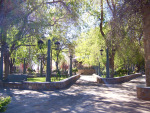
I parked the Jeep next to one of the more ornate restrooms I’ve ever seen. Ghost like, abandoned, some weeds and puddles near the entrance, but inside, shiny tile floor, gleaming metal and glass work, running water. Everything functioned perfectly, as if the last user had just left and more would soon appear.
Outside, I faced a stone wall an d a fancy stairway. I climbed to the top and looked down into an arena with seating for thousands. To my left, a wide alleyway for horses, bulls, or other four-legged participants; to my right the arena itself, above it the seating rising like a tiara of masonry and fancy stonework. From my perch on the wall, I could see the entire arena. It was empty.
d a fancy stairway. I climbed to the top and looked down into an arena with seating for thousands. To my left, a wide alleyway for horses, bulls, or other four-legged participants; to my right the arena itself, above it the seating rising like a tiara of masonry and fancy stonework. From my perch on the wall, I could see the entire arena. It was empty.
I climbed down the stairs and walked along the great wall of the arena. Beyond it, a tree-shaded plaza came into view. The centerpiece was a large fountain. Around it, stone paths wandered among designer shrubs and long rectangular fish pools. I could see buildings through the trees along the plaza, two-story stone house s with balconies. Yet I was completely alone. I might have called it a ghost village, if it was not too large, too impressive, too well-kept for such a description. It was more “Brigadoon” without the townspeople.
s with balconies. Yet I was completely alone. I might have called it a ghost village, if it was not too large, too impressive, too well-kept for such a description. It was more “Brigadoon” without the townspeople.
My time was short; forced to drive away, I had to leave this miraculous place scarcely explored. I knew something of the back story from my friend––of the Mexican dishwasher turned successful restaurateur who wanted to build a replica of his home village on 500 acres of land in the dry Cuyama Valley, of his desire to bring in visitors, to host rodeos and shows, until permit woes drove him back to Mexico in despair.
I knew something of the decades of intricate, difficult work to hand build everything in the village, train laborers in the fine craftwork, shape every cobblestone by hand. Later, after some research, I learned more of the man and his project; the details only increased my wonder.
While researching, by sheer, magical coincidence I came across an article in the Santa Maria Sun, a cover feature story published in 2006 in which reporter Craig Shafer tells the entire unbelievable story and of the documentary film currently in the works. You owe it to yourself to read this story.
Late addition: The film on Vimeo


April 22, 2016
A Note for my Blog Followers
Dear Friends,
My newest novel in the Zack Tolliver FBI series, CAT, is currently in publican at Amazon as an eBook. We intend to publish the paperback version by June 1.
eBook sales success is tied to several events in the life of the book, the most important the launch. Th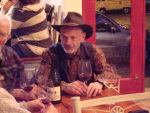 e Amazon algorithm takes into account the volume of sales when the book is first published. This effects future visibility and sales.
e Amazon algorithm takes into account the volume of sales when the book is first published. This effects future visibility and sales.
If you read eBooks and plan at some point to purchase CAT, you will help the author two-fold if you purchase it at or near its initial publication date.
There are other ways you can influence sales of books. I have listed several in my latest blogpost.
Check my site (LAWritersblog.com) periodically for news of free books, countdown deals, prizes, etc. I post such information for my friends on that site before all others.
I hope you continue to enjoy reading about Zack Tolliver and Eagle Feather’s adventures as much as I enjoy writing them.
R Lawson Gamble


April 20, 2016
Help Your Favorite Author (and yourself)
There is a growing symbiotic relationship between authors and readers. Like horse and carriage, you can’t have one without the other. Of course, a relation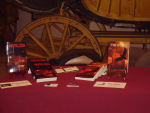 ship has always existed, but until recently it was always somewhat removed, stand-offish, like the maiden aunt who visits you once a year.
ship has always existed, but until recently it was always somewhat removed, stand-offish, like the maiden aunt who visits you once a year.
Over the centuries, readers have had to read the books available to them. Seldom have individual readers directly influenced the publishing industry. Sure, a publisher always tried to be aware of the general trends and proclivities of the reading public. But ultimately the choice of what to publish, and what not to publish, belonged to them, and they were tight-fisted with it.
Today readers wield direct and immediate leverage in regard to books and authors. In sites such as Goodreads, Amazon, and a multitude of others, it is the reader who decides what books and which authors will succeed. It is a much more democratic system than in the past.
I have great respect for Penny Sansevieri. An expert book marketer, she was among the first to understand this phenomena and revel in it. Hers was one of the first marketing companies to cater specifically to eBooks, and one of the first to see the potential of Amazon for readers and authors alike.
Penny has shared 5 quick ways a reader can help a favorite author. I share them with you now. The italics are my additional thoughts.
1. Buy their books. Whether it’s an eBook, or print, or as a gift––get a copy. eBooks are CHEAP. Buy a bunch.
2. Review their books. Reviews really do matter, so take a few moments on Amazon, Good reads, or wherever you can, to give it five stars. Reviews are the game––no kidding. The buyer’s first glance is at ratings to decide quality, second glance to reviews to decide if it is suitable to them. Amazon (and other retailers) absolutely use numbers of reviews in determining which books will be most visible.
3. Follow them and share. Follow the author on social media. Then, don’t forget to share. Let your peeps on social media know, put together a blog with a list of your favorite reads, or post pictures of you holding their book. Social media helps, of course, if it expands visibility. Visibility is what it is all about.
4. Recommend them. Are you part of a book group? See if they’ll consider the author’s book for the group. Recommend the book on Goodreads. Share with a friend. Word of mouth remains the very best sales tool.
5. Offer to help. Have you ever asked an author if there’s something else they need? Perhaps you can take their book into your local library, or bookstore, and see if they’ll carry it. Grab some of their bookmarks and share locally. As an author, I would love to see a friend, fan, or family initiate contact with bookstores and encourage them to carry a physical sample of my books on their shelves. There needs to be an army for this, it is just too difficult for one author to get it done, and maintain it.
For more from Penny, you can find her at AMarketingExpert.com.
LAWritersblog.com
Tagged: authors, book marketing, book sales, E-book, FaceBook, Goodreads, marketing, readers, Review, Social media


April 9, 2016
Ten Truths About Publishing
A great benefit to membership in Sisters In Crime is their newsletter. Within it are links to newsworthy blogs, columns, and other great sources. Usually, the selected articles are of great interest to writers, perhaps less so to indie publis hers.
hers.
Not this time. Several pieces in the April newsletter discussed self-publishing. In one particular article, Daniel Berkowitz interviews author Hugh Howey on the role of self-publishing in today’s book publishing landscape.
I enjoyed Howey’s responses. He made sense to me, possibly because his ideas align closely to my own.(see But What About Us Readers?)
Below are 10 of his most insightful thoughts.
1. Major publishers will eventually need to compete with Amazon’s 70 percent earnings––somehow, some way.
2. The key advantage to self-publishing is price control.
3. Self-publishing is faster, pays better, offers more creative opportunities, allows experimentation with price and other features.
4. Amazon is the best self-publishing platform for new authors. Debuting authors should go exclusive with Amazon until they have gained enough traction to branch out.
5. Amazon’s KU exclusivity is for 90 days at a time, whereas traditional publishers exclusivity is for life – plus another 70 of your heirs’ lives.
6. Amazon has had a positive effect on indie bookstores, which are currently making a comeback.
7. Authors need lots of titles out there to build momentum, hone their craft and find a voice.
8. Do not spend writing time marketing. Most marketing tactics don’t work.
9. Interact with your readers, be yourself on social media. Don’t sell. That’s what sells.
10. The world will never go back to the days when publishers owned a monopoly on readers’ attention.
Nuff said.
Tagged: Daniel Berkowitz, Hugh Howey, indie bookstores, Indie publishing, marketing time, percent earnings, publisher contracts, publisher exclusivity, publishing speed, royalties, self-publishing, Sisters In Crime


March 17, 2016
The Sky Is Falling
Several res pected bloggers have begun to back away from self publishing books. They have crunched numbers, which most recently suggest an increase in the percentage of traditionally published books along with a decrease in self published Ebooks this past year. There is a rise in hybrid publishers (authors who do both) and an increase in Ebooks from traditional publishers. What should an author read in to this? I believe, nothing.
pected bloggers have begun to back away from self publishing books. They have crunched numbers, which most recently suggest an increase in the percentage of traditionally published books along with a decrease in self published Ebooks this past year. There is a rise in hybrid publishers (authors who do both) and an increase in Ebooks from traditional publishers. What should an author read in to this? I believe, nothing.
Evolution has always stuttered its way forward, with blips and bumps. It is why we still have tails. Because these blips are on a global eonic scale the true overall movement is difficult to discern. Just ask North Californians this year. Drought? What drought? Global warming? What’s that?
Indie publishing reminds me of an oil spill in the ocean. The volume of oil is small at first, doesn’t mix well with water, keeps to its own slick while people try in vain to clean it all up, finally finds its place, settles there and remains forever, slowly accumulating. Each type of publishing serves a different need. There will always be a balance of sorts.
One piece of interesting data crunched was the very high percentage of smart phones used for reading books as opposed to other devices. That struck me as odd at first––those readers must have way better eyesight than me. After some thought, I realized it illustrates the pace of the world with which many people exist. A quick book download while waiting for a flight, flip to the phone when the boss rings, then back to the book until the flight is called. Perfect.
What does this mean to authors? Shorter books, more action, simpler plot lines? Possibly. It also means a lot more books are being read a lot faster. Increased consumption means an increasing need for books.
Another bit of data dealt with the high percentage of time spent marketing versus time for writing for those who publish and market their own books. It’s way out of proportion. Marketing is extremely important to book sales, and it is a lot of work. A benefit of traditional publishing, the pundits suggest, is the marketing arm of the company. They point out no individual author commands the power, influence, and connections available to a publishing company. The publishing company has many more bullets in its gun.
I have two questions. First, for whom are these bullets expended? Probably not the mid-list author––that is, most of us. Second, how much marketing does it require to match the royalty income of the Indie publisher after percentages for agent, publisher, and whatever else are deducted?
The point is, Indie publishing will not go away. There will always be a market––a large market. The door has opened for anyone who ever dreamed of writing to give it a try; that door can never be closed. As far as I’m concerned, that’s a good thing.
Tagged: book marketing, book sales, E-book, ePub authors, Publishing, sales, self-publishing, traditional publishing


R Lawson Gamble Books
- R. Lawson Gamble's profile
- 27 followers



